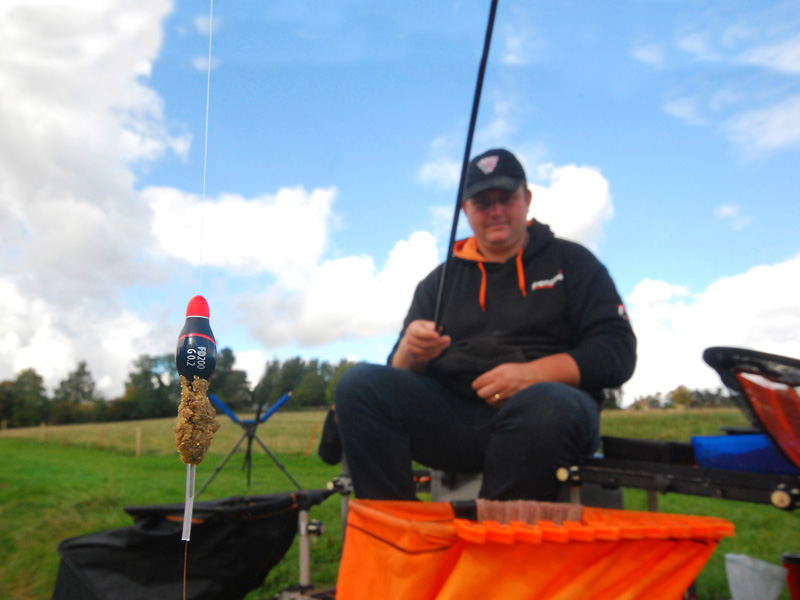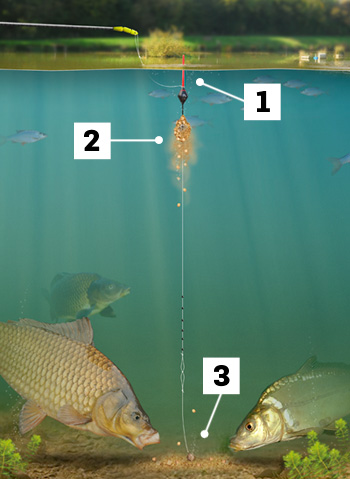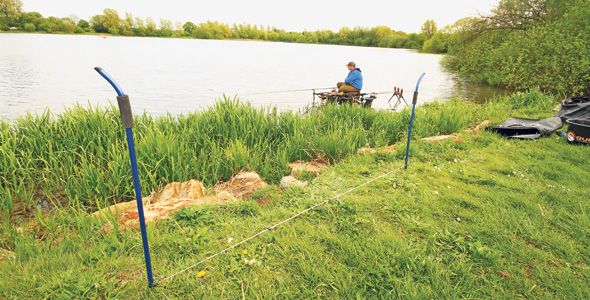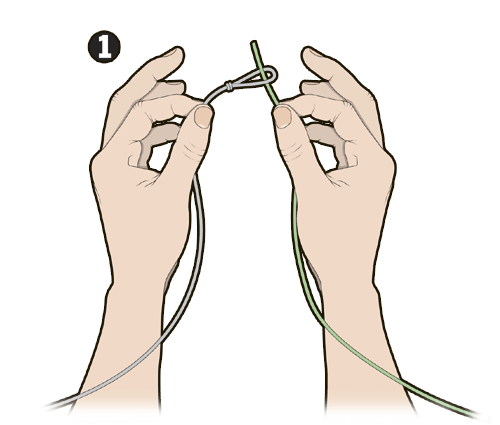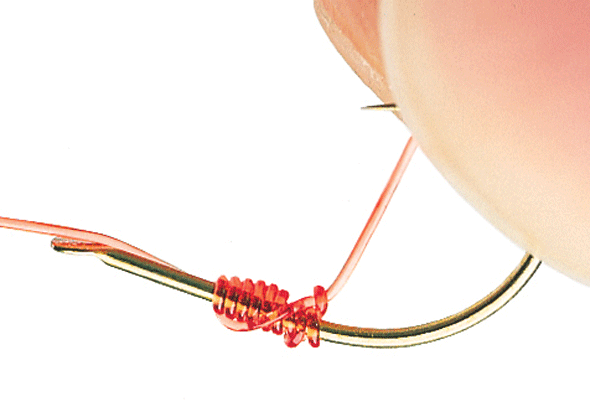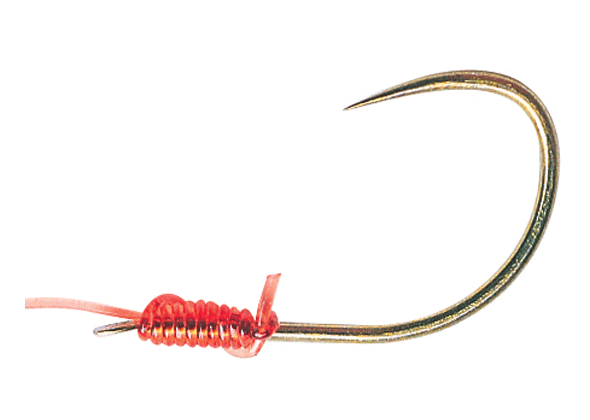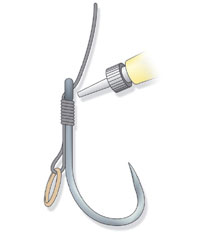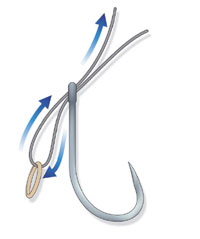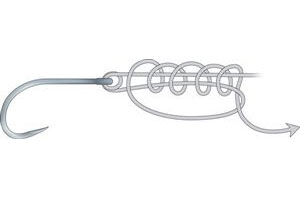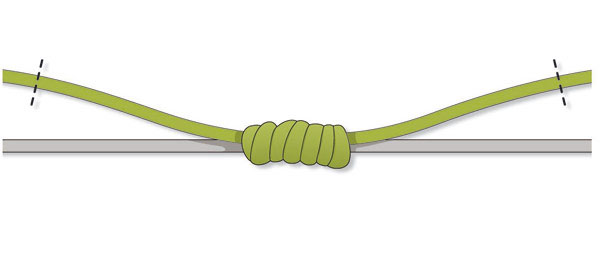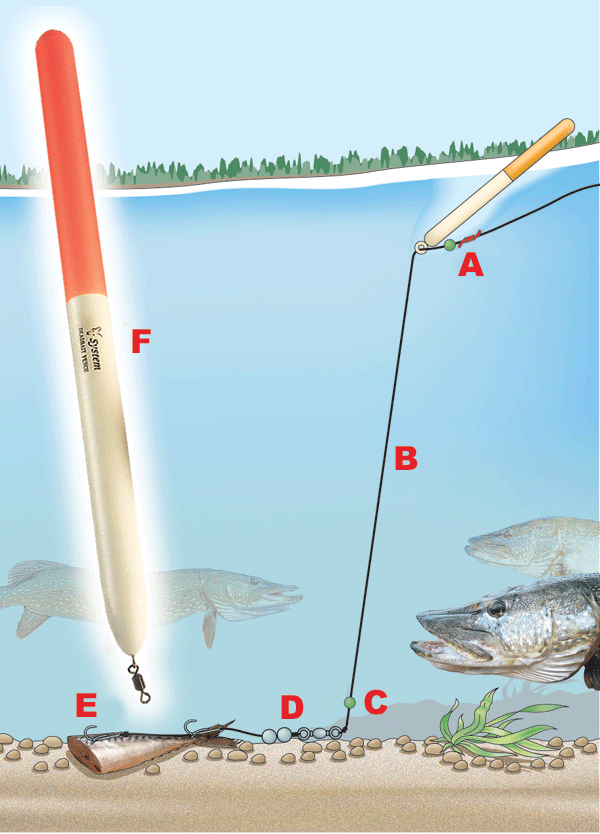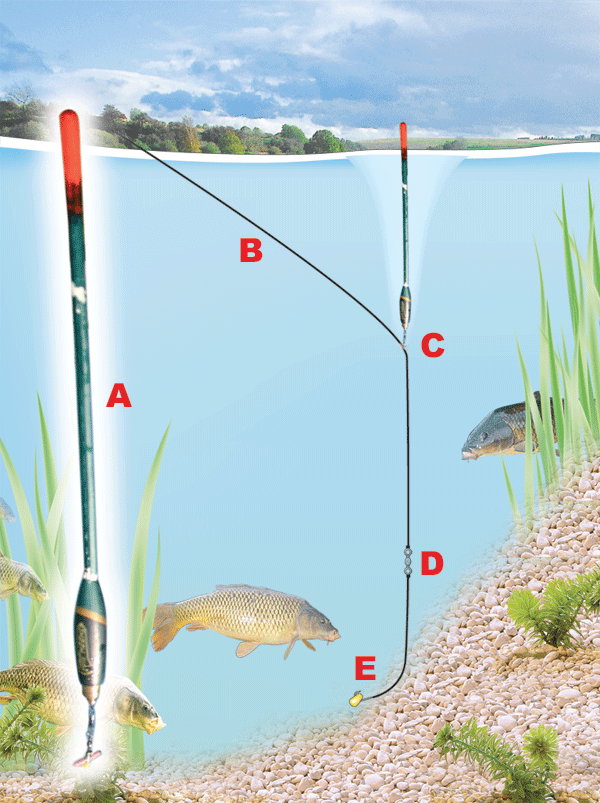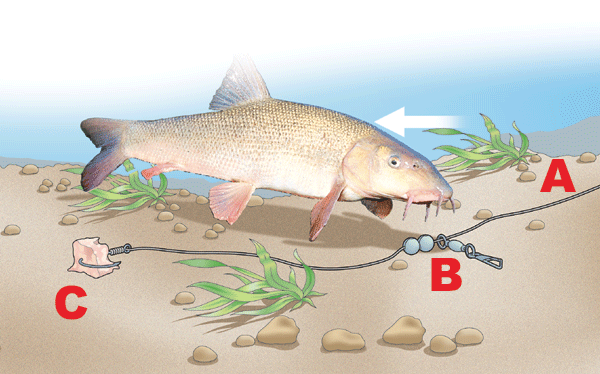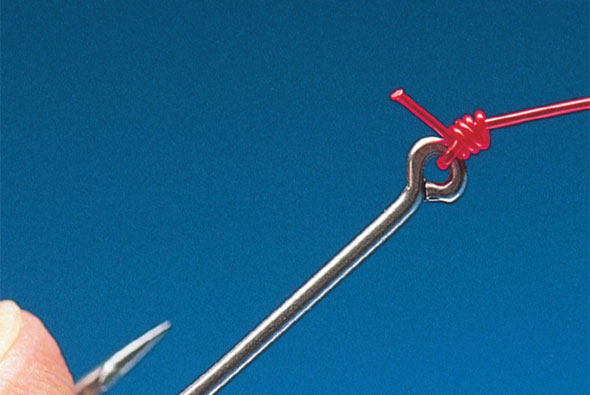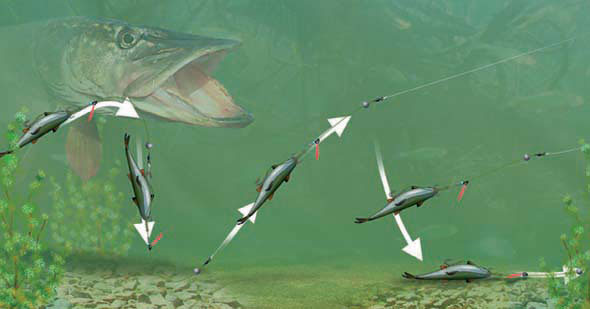PERCH FISHING RIG | How to tie a perch float rig
You will need...
• 3AA bodied waggler
• 5lb mainline
• 4lb hooklength
• Size 10 Nash Fang Uni hook
Here’s a precisely set-up float rig to eliminate the resistance perch hate, which also has the benefit of working well for targeting even larger species
Perch are very obliging fish that can be caught in many different ways, but one of the finest has to be on float-fished worm or prawn.
These larger baits help to deter small fish from picking up your bait giving you a good chance of latching on to a larger than average specimen.
Perch do not like a moving bait, so it is much better to nail it to the lakebed by fishing slightly overdepth with a small shot to anchor the float in position.
Having plenty of shot down the line also helps to keep the rig in place and stop it from being moved around.
Perch bites are normally very bold, but with this rig you can shot the float down so that only the tip is showing when the No.4 shot rests on the bottom.
Should you cast out too far, the shot will not be on the bottom and the float will disappear, telling you that you need to fish a little closer. This rig will also work well for other larger fish – bream, tench and carp.
1. Lock the float in position with two BB shot. These shot should not be pinched on too hard, so they can be moved to adjust the depth once you start fishing
2. The bulk of the shot, made up of several BBs is positioned at just over half depth. This group of shot will get the hookbait down quickly and give the rig stability
3. Tie a double overhand loop knot in the end of the mainline. The loop should be about 2cm in length. The hooklength will later be attached to this
4. Cut off 45cm of 4lb clear line to make the hooklength. It is important to use a hooklength that is lighter than the mainline in case you need to pull for a break
5. Tie a size 10 hook on to the hooklength using a spade-end knot that has first been passed through the eye. This is a very strong knot, ideal for hook with large eyes
6. Next, tie a simple double over-hand loop in the end of the mono hooklength. The hooklength should ideally be about 20cm in length once finished
7. Add a No.4 shot 12cm above the hook. When setting the depth ensure that this shot is on the bottom to secure the hookbait in place
Large baits such as lobworms help to pick out the bigger perch in your swim
How to tie the Carolina Rig
A: The action of the nose cone hitting against the glass bead on the retrieve makes a tapping noise which can induce a take
B: The leader section enables the lure to flutter to the lakebed under its own weight, which can encourage more bites
C: Because the hook point sits flush to the back of the lure, it is impossible for it to snag up in weed
When faced with a weedy river swim this lure set-up is almost impossible to snag up and is great for big perch....
Originally developed by bass anglers in the USA, the Carolina Rig has proven just as deadly for perch on this side of the Atlantic.
Designed to fish a soft plastic ‘creature’ bait close to the bottom and among thick weed, the Carolina rig has the great advantage that it is almost snagless.
This is because of the special wide gape offset hook that is used, and which are now available from several specialist lure outlets in the UK.
With the hook sitting flush with the top of the bait, this rig can be fished amid plants and sticks with little chance of snagging.
The Carolina rig is fished with a slow lift- and-drop retrieve that enables the soft plastic bait to wiggle enticingly as it moves forward and then flutter weightlessly down as the retrieve is paused. This action is very effective for perch and can also be used for zander too.
While drop shotting is rightfully very popular, other tactics such as the Carolina rig are great alternatives and well worth adding to your repertoire.
HOW TO TIE IT
1. Cut off a 24-inch length of 8lb fluorocarbon line to make the hooklength. Hold on to both ends and pull to straighten the line
2. Tie on the offset hook using a four-turn grinner knot. With fluorocarbon, only one pass through the eye of the hook is required
3. Tie a mini swivel to the other end of the hooklength using a four-turn grinner knot. Wet with saliva before pulling tight
4. Slide a 10g-15g bullet weight on to the mainline braid and follow with an 8mm glass bead. Tie braid to the swivel with a four-turn grinner
5. Thread the hook through the head of your creature bait and then back through the body so that the hookpoint lays flat against the back
6. A striking fish pushes the hook through the bait exposing the hookpoint, yet the lure will glide effortlessly through snags and weed
Tie a pole float baggin' waggler
The baggin’ waggler is one of the best ways to enjoy consistent sport. The large, cigar-shaped floats with a small Method feeder attached to their base enable the angler to fish a hookbait in a column of feed.
If you use one of these beasts in the winter, though, you risk killing the swim. But by scaling down and using a pole float and a small bait coil, Dean Jones has created a rig more suitable to the demands of winter fishing.
Baggin’ wagglers have been around well over 25 years. The theory of fishing a hookbait through a tight column of falling loosefeed is relevant at all times of the year; it just needs to be scaled back in the colder months.
There are problems with other forms of loosefeeding. The pole pot is a one-shot deal – once the feed is fed, the pot is empty – and with a catapult, the loosefeed gets spread over a wide area. So when you need to keep loosefeed tight, neither is particularly appealing.
“To solve this problem I came up with the baggin’ pole float. By sliding a Korum bait spring on to the stem of a pole float, I created a mini baggin’ waggler. The results have been nothing short of brilliant,” said the Frenzee and Bag’em Match Baits-backed rod.
“I have found that I am now able to feed with great accuracy, and my hookbait can be fished hard on the deck or up in the water,” said Dean.
Dean’s pole float set-up
The beauty of Dean’s approach is that you can use whatever tackle you want, the only stipulation being that the pole float is large enough to cope with the extra weight of the additional loosefeed packed around its stem.
Dean recommends a float of at least 0.4g but 0.5g or larger is better, depending upon the amount of loosefeed you are planning to fish.
“In the depths of winter, I use a small coil and place a few shot down the line to trim the float correctly,” he explained.
“On milder days, like today, I dispense with the shot altogether and just use the loading of the feed to trim the rig. When all of the loosefeed has broken down, the float rises in the water, signposting that it is time to rebait the spring.”
To create the pole float baggin’ waggler, Dean follows the time-honoured way of making a pole float rig, only with a slight difference.
After threading on the silicone, he then slides a thicker tighter length of tubing on to the mainline, followed by the bait spring and then the pole float. The components are then pushed together. As for the rest of the rig, it is up to the angler to use components they’re are most happy with. Dean opts for Frenzee Vertex 0.15mm (4lb 13oz) mono that doesn’t kink under the strain of the ball of feed because it is thicker.
“I generally fish the mainline through to the hook, unless I’m targeting small carp or silverfish, when I will use a lighter hooklink.
“Hook size depends on the hookbait I am planning to use. Today I have a 6mm expander on the hook, to a size 16. If I was after silverfish, using a maggot hookbait for example, I might use a size 18,” said Dean.
The float’s loosefeed
For the all-important free feed, Dean reckons that groundbait is the best, with a few particles added to ‘match the hatch’.
The great thing about groundbait is that it creates a cloud that attracts fish but doesn’t feed them.
Plus, if you start with groundbait, it is almost impossible to overfeed the swim.
Yet if the fish are feeding confidently on the day, he will increase the amount of particle to crumb to help hold them in the swim for longer. For today’s session, he found a 70:30 mixture of groundbait and micro pellets was about right. Dean steers clear of Method mixes as they are too stodgy and do not break down nicely in the swim.
“I have found a 50:50 mixture of XP and Commercial Carp works best. The XP is used to create the bulk of the smell and cloud, the Commercial Carp for its binding power. If you do add particles – such as a few pellets – only put them in after the groundbait is correctly mixed to prevent them taking on water and expanding because they can stick in the spring’s coils.”
Once the bait is mixed, it is then a case of gauging the amount needed to load the float. That is the beauty of this rig; you don’t need pole pots or cups, as the baggin’ waggler action of the rig does everything for you.
“Like all matchmen, I am always on the lookout for that next edge that will help take my angling to a higher level. I can’t believe that no-one else has tried this before. It has certainly made a massive difference to my cold-water catches,” concluded Dean.
POLE FLOAT BAGGIN' WAG
1. Once the bait has fallen off the spring the float will rise in the water so you know it's time to refill it
2. The groundbait creates a cloud of attraction. A few pellets will help to hold the fish in the swim for longer
3. With this tactic the hookbait can either be fished up in the water or on the deck
Dean’s tackle
- Pole: Frenzee Precision FXT 16m Pole
- Elastic: Frenzee Stretch Hollow Elastic green
- Float: Frenzee
- Mainline: Frenzee Vertex 0.15mm (4lb 13oz)
- Hook: Frenzee 1420 Pattern size 16
- Loosefeed: Bag’em Matchbaits Commercial Carp, Bag’em Matchbaits XP groundbait
- Hookbaits: Bag’em Matchbaits Super Natural Carp Pellets 2mm, Bag’em Matchbaits Easy Xpanda pellets 6mm
Five hair rigs to try now
Making rigs isn’t the most exciting part of fishing, but fail to pay attention to every aspect of your set-up and you’ll pay the price on the bank.
Most anglers make sure that their rigs include an appropriate float shape, line strength and hook size, but they often give little thought to other elements that are equally important.
One area of your approach that may see very little effort put into it is creating the perfect hair rig.
It would be easy to think that how you present something so small and seemingly insignificant could matter so much, but top matchman Andy Quarmby knows all too well that such a mind-set can prove very costly.
Attention to detail
A lot of Andy’s match fishing success has been achieved at venues where hair-rigged baits score heavily, and through trial and error he has realised that the slightest variation can make a big difference.
“People think that every hair rig is the same, but the way it is tied can be changed every time to suit the scenario,” explained Andy.
“I have them tied up long, short, with bait bands or bait spikes. Each way has its uses, and your success or failure is often determined by making the right choice on the day.”
The Middy-backed rod believes every angler should get busy tying up a range of hair rigs. Here he reveals his five favourites that will help you keep the fish coming on stillwaters...
FIVE TOP HAIR RIGS
1 Triple corn
Many anglers may think this is what I would use in winter when casting around on the bomb, but it is actually one of my favourites for fishing down the margins. I like to tie the hair rig
long, so that it holds the three grains of corn and also leaves a slight gap between the bend of the hook and the nearest kernel.
A big and bright hookbait is important in the edge, but if you hook three grains of corn directly you are guaranteed to mask the point unless you use an overgunned hook size.
My favourite type of hook is a Middy KM3 in either size 14 or 16, with a 0.20mm hooklength that will easily cope with fish well into double figures.
2 Double 8mm pellet
If you think a bait band can only get one bait in it, then it is time to think again.
On heavily pressured venues where the fish have seen every trick in the book, a couple of 8mm pellets presented tightly together is an unusual offering that can fool even the wiliest carp.
Just make sure the hair rig is long enough, so that none of the pellets get in the way of the hook itself.
3 Hooked band
When I am fishing on the bottom for a wide variety of species, I prefer to hook the band directly. This allows me to use a hard pellet and stops me getting pestered by small silverfish. The bait is presented in a similar manner to if it was directly hooked, and a 4mm or 6mm bait offered like this will help you catch a real mixed bag of carp, F1s, bream and tench.
4 Short hair
When shallow fishing for F1s I go the opposite way, using a very short hair with a band on it so the bait touches the bend of the hook. This is because F1s are fickle feeders. The moment they suck the pellet in they are likely to feel it is unnatural and will eject it almost instantly. A long hair rig would lead to you striking at nothing, but a short version gives the fish little chance of escape once they’ve decided to slurp in your pellet hookbait. Fine your tackle right down for F1s, with 0.12mm hooklengths strong enough for even the biggest examples of the species.
5 Long hair
If I am going to fish up in the water for mirror or common carp, this is the only type of hair rig I will consider. I am convinced that the band being sat off the hook gives them an extra second to swallow the bait properly, and this leads to the hook penetrating after every bite.
I tend to scale down when shallow fishing and use a soft elastic to absorb the ferocious bites. A 0.14mm hooklength to a size 16 KM2 hook is more than ample.
ROLFS LAKE DEMO
Oxfordshire’s Rolfs Lake is one of the fisheries where Andy has perfected his attack. The fish were stocked small, but have grown well into double figures as the years have gone by.
“These carp have seen every trick in the book and every detail needs to be looked at. Using the right hair rig is a big part of that,” he said.
Three lines were set up for the demonstration – on the deck at 5m, shallow at 13m and down the margins.
Each had a different hair rig, and in four hours’ sport Andy barely missed a bite, with carp to over 10lb and a few bonus bream coming to the net.
To prove that the hair rig was an important part in the catch, he switched to a short one while fishing shallow and he instantly missed a run of bites.
“I never thought for one minute in the past that such a tiny change could make the difference between landing an odd fish and 100lb. Pay attention to your hair rigs and your results could suddenly rocket,” he said.
How to tie a long-range bream feeder rig
Steve Ringer explains the secret tactics behind his match successes
I’m often asked what the secret to success is when fishing big lakes such as Ferry Meadows. Most people think a magic bait or some kind of secret trick is involved.
The reality is very different. I believe a lot of my wins are down to accurate casting, and use of the right rig.
It makes perfect sense. After all, you can have the best bait in the world but if you can’t cast to the same spot twice then you are never going to be able to build a swim, and this is crucial when fishing for bream.
THE RIG
1. Hooklengths
My hooklength is attached to the tiny loop at the end of the twisted loop using the loop-to-loop method. At Ferry Meadows the bream run big, so normally I will kick off with 50cm of 0.17mm N-Gauge line to a size 14 MWG eyed, barbed hook. This is tied using a knotless knot but instead of a hair at the end I tie in a Speed Stop.
This way I can hair-rig pieces of worm and this prevents them wriggling over the point of the hook, something which can be a real problem when hooking the worm in a more conventional manner.
2. Mainline and shockleader
When fishing accurately at range for bream it’s essential that you use braid for your mainline.
There are two big advantages to using braid for distance work. First, its low diameter enables you to cast further, and second, it has no stretch, so both accuracy and bite detection are massively improved.
I’m currently testing a new braid for Guru called Pulse8 in 0.10mm diameter, and to say I’m impressed is an understatement.
I then attach a shockleader of 10lb Tournament ST to the end of the braid.
Being so fine and with so little stretch, braid isn’t ideal for casting off and can cost you when playing fish under the rod top as it’s so unforgiving.
I like to have around four or five turns of the shockleader on the reel when the feeder is in the casting position.
3. Anti-tangle set-up
The most important quality of any feeder rig is that it doesn’t tangle, and this is particularly true when fishing for bream at range.
To avoid this I use a mixture of a stiff feeder link and a twisted loop. Firstly I make a 6cm feeder link with 20lb Korda IQ fluorocarbon line with a small snap link swivel at one end and a Hobbycraft ‘seed bead’ at the other Both of these are crimped in place.
My mainline shockleader is then threaded through the seed bead at the top so the link can run freely on the mainline, and a feeder is clipped on to the snap link below.
Once the link is on the line I thread two tiny beads on to the shock leader to act as a buffer and protect the knot from damage during the cast.
The next step is to twist up the last 15cm of the shockleader and tie it off with a double overhand loop knot. This twizzled loop makes the line below the feeder much stiffer, which again greatly reduces the likelihood of a tangle. Finally, the hooklength is tied to the twisted loop, loop-to-loop style.
4. The right feeders
There are two types of feeders I use for distance work. The first are Kevin Leach feeders, which I find the perfect pattern for distances between 40m and 70m.
They are wire cage feeders with all the weight round the bottom, which ensures they fly straight on the cast. I use 30g and 40g sizes the most, and the further I’m casting, the heavier the feeder.
Anything over 70m and I’ll opt for the Matrix Horizon feeders which have a bullet at the base to help them cut through any cross or head wind. With these, distance can still be achieved in even the worst conditions.
In terms of weight, normally it’s anything from 40g to 60g, depending how far I’m looking to cast.
HOW TO CAST A FEEDER ACCURATELY
1. Longer drop
Often I see anglers try and cast with too short a line between feeder and rod-tip. I like to have the feeder just above the halfway point of the rod. This allows me to compress the blank so I’m working the whole rod, not just the tip.
2. Pick a marker
Once you are about to cast it’s important that you have some sort of marker to aim at – this can be a tree or a building, basically anything that’s easy to spot and isn’t going to move. Boats are not reliable markers! Once you have your marker you need to ensure you’re aiming at it every cast.
3. Give it some welly!
Don’t be afraid to compress the blank and give it some power. You have to make the rod work.
You need to point the rod at the marker all the way through the cast, and that way you’ll know the feeder will fly straight and true.
MEASURING THE DISTANCE
Measuring sticks are something I first started using around four years ago after seeing them at the World Feeder Champs in Italy.
Now I can honestly say I wouldn’t be without them.
Basically they are two bank sticks with a length of string between them. The idea is that you place them a set distance apart determined by the string and then use them to measure how far you are casting.
The way they work is that you drop your feeder by one stick and then wrap the line round the other and then back again until you reach your clip. So for instance, if my sticks are at 3m and I go round 20 times then I know I’m fishing at 60m.
To sum up, by using the sticks I know exactly how far out I’m fishing and I can easily clip up other rods to fish at the same distance.
How to tie a drop shot pole rig for catching carp
Drop shotting has taken the nation by storm, but Middy’s Craig Butterfield has taken the tactic to new levels by incorporating it in a deadly new pole rig.
Bites can be hard to hit when fishing shallow because of the pace the carp attack the bait, slurping in the pellet and ejecting it before you’ve even had chance to react.
But Craig’s new rig removes the need to strike. Instead the fish hook themselves almost every time.
“If the fish swims down it hooks itself against the weight of the pole tip, and if it swims sideways or upwards it is the weight of the drop shot that sets the hook,” he explained.
“Self-hooking pole rigs often get a bad press, many saying they take the skill out of fishing, but I don’t agree. They give you no more help than a Method feeder with a short hooklength or a bolt rig when specimen fishing.
“The skill with this tactic is correct feeding and working out at what depth the fish are feeding.”
The rig looks a tad confusing at first sight, but it is very simple to tie if you follow the five-step guide below.
1 Thread a metre of mainline on a size 18 eyed hook so that it is around 30cm from one end.
2 Tie a 15mm loop with the hook running freely inside it to help it sit correctly and look natural.
3 Place your fingers 3ins either side of the loop and twist in opposite directions.
4 Hold the line together and tie another loop to create the stiffish paternoster.
5 Add a drop shot weight to the shorter length of line and a pole float as a bite indicator.
6 The final ‘drop shot’ rig is a valuable component of any commercial angler’s armoury.
How to tie Alan Scotthorne's Hooklength Knot
Here Alan Scotthorne reveals the knot that he uses to join a hooklength to his fishing mainline. It's a variation of the loop-to-loop method, but with a twist. It's easy to tie and incredibly strong...
Alan Scotthorne was never really happy with using loop to loop knots for joining his mainline to his hooklength namely because it can potentially cause tangles and it's untidy.
After experimenting with lines he came up with this knot. Well, it's actually not really a knot - it's more of a way of wrapping and twisting a line onto a loop of line. This makes this knot very strong indeed, and therefore reliable enough to be used on silverfish through to commercial carp waters.
But it's developer and creator proves just how reliable and effective this knot it. If it's good enough to a five-times World Champion to use, it must be good enough for every other angler!
Here's how it's tied...
1 Tie a small loop in the end of your mainline and then pass your hooklength line through the loop like this.
2 Hold the line in your left hand and then double it up with your other hand to create a loop in the hooklength line.
3 Twist the end of the hooklength that is held in your right fingers. This causes the line to spin and twist around the other section of hooklength line.
4 Pass the other end of line, with your hook attached, through the loop that is created when twisting the hooklength line.
5 Moisten the line and pull the knot tight. The tag ends should be trimmed right down as this knot refuses to slip.
How to tie the Domhoff fishing knot
Although detailed here using a spade end hook, the Domhoff fishing knot can be used around the shank of an eyed hook, and when tied securely this is an incredibly reliable knot to use.
It is made up of a series of eight whips around the hook shank. This creates a neat lock upon the hook that won't slip and will not lose any strength as the line is pulled tight.
Most anglers do use this knot for tying their spade end hooks (if they don't own a hook tyer) but if you're suffering lost hooks or broken knots when fishing with eyed hooks you really ought to give this knot a try as it's super-secure.
It can be used to tie the tiniest of hooks through to whopping size 2 speciimen eyed hooks - all you have to to is match the strength of line to the hook size and guage and you're on to a winner.
Here's how to tie the Domhoff fishing knot in six easy to follow stages...
Make a loop in the end of your line. Lie the loop against the shank with about 1cm beyond the bend of the hook. Hold it tight in place between finger and thumb.
Now take the free end of the line and start to wind it up the hook shank, holding the loop between thumb and forefinger and securing the other part of the line underneath the coils. Keep everything under tension.
After eight turns or so trap the whippings with your other hand to reveal the loop.
Now pass the loose end through the loop.
Dab with a touch of saliva and tighten by pulling on the main part of the line. Make sure the line leaves the hook from the front of the spade or the eye and the coils are neat.
This is the finished knot. Tie off the tag end neatly.
How to tie the banded knotless knot
This relatively new knot is one for the angler who needs to catch, bait up and fish at speed.
It gives the angler the hooking power of the knotless knot, while at the same time provides the angler with the ability to attach hard baits like pellets, on to the hair, really quickly.
There's no need to use a drill, a baiting needle or a hair stop when using this knot - the tiny bait band grips around the circumference of the hard pellet secrely enough so that the bait can be cast.
STEP 1
Thread your hooklength through the front of your eyed hook then through a bait band. Now pass the hooklength through the back of the eye of the hook.
STEP 2
Adjust the length of the loop that holds the bait band until the top of the bait band sits at the top of the bend of the hook
STEP 3
Hold the bait band and hooklength loop securely. Take the tag end of the hooklength and whip it around the hook and hooklength loop. Whip the line around eight times, keeping tight turns at all times.
STEP 4
Ensure all the whippings are secure and tight, then make one final whip up and over the previous whippings, then thread the hooklength tag end through the back of the hook's eye.
STEP 5
Add a drop of Superglue to the whipping to secure it in place, then trim off the tag end as close as possible to the eye of the hook.
How to tie the grinner knot
This knot is widely used by match, pleasure and specialist anglers wordwide, for linking hooks and swivels to either mainline, hooklength or even braid.
It is a very strong and relaible knot that should be dampened thoroughly before it is pulled tight.
As this knot features a small amount of whipping above the swivel or hook eye it does not 'strangle' the item being tied, therefore it retains a huge amount of strength.
STEP 1
Pass your chosen hooklength through the eye of your hook or swivel twice. Pull 4ins of the hooklength through. Now form a loop with the tag end of the hooklength.
STEP 2
Thread the tag end over the hooklength and through the loop four times, making sure it exits through the loop.
STEP 3
Moisten the knot thoroughly with saliva and gradually pull it to lock the knot against your hook eye or swivel eye. Trim any waste from the hooklength tag end as close as you can to the knot.
How to tie the stop knot
The Stop Knot is commonly used by match anglers who need to floatfish a waggler in water much deeper than the length of their rod, but it is even more commonly used by predator anglers when they create their float rigs.
A well-tied Stop Knot provides a moveable point that helps prevent your float from sliding all the way along your mainline, and if it is tied using a length of flexible mono, it will cast through the rings of any match rod on the market.
Specialist anglers tend to use powergum to tie their stop knots, which will still pass through their rod's rings because of the large internal diameter of them.
STEP 1
Lay a 6in length of powergum or thick mono alongside your mainline.
STEP 2
Form a loop with the powergum or mono and thread one end through the loop and over your mainline.
STEP 3
Repeat threading the powergum or thicker mainline through the loop and around your mainline four or five times.
STEP 4
Moisten the knot with saliva, slide it into position upon the mainline then pull it tight. Trim the tag ends to around an inch from the knot.
How to tie the water knot
This knot has many uses for the angler. It can be used to link hooklength to mainline, it can be used to join a paternoster link to a mainline, and it can even be used to join mono to braid.
Many angler's use this knot to link their pole mainline to the hooklength, especially when fishing delicate rigs, because it is far more direct than the more commonly used loop to loop technique.
STEP 1
Lay the two lines you wish to tie alongside each other.
STEP 2
Form a substantial loop using the two lines
STEP 3
Ensure the two lengths of line are together and thread the pair of tags ends through the loop three times.
STEP 4
Moisten the knot with saliva or water and slowly pull it tight. Trim off the tag ends accordingly to either create a straight profile when joining a mainline to hooklength, or cut the tag ends to create a paternoster link for legering purposes.
How to fish the lift method for carp, tench and bream
This technique is brilliant for tackling the margins. It was made famous by John Wilson, who has used it extensively for carp on many of Britain's lakes to catch countless fish of all sizes. It works with almost all baits, including boilies.
A The lift method works best if the float rod is placed upon rod rests. This ensures that the rod tip and the line remains stationary, and subsequently the float isn't pulled off line.
B It's best to use large, unloaded floats that offer a lot of buoyancy. When set correctly the float tip should only just break the surface. When a fish takes the bait and therefore lifts the shot that lies on the bottom, the float will rise to indicate a bite.
C Use the bare minimum of shot to lock the float upon the line. Ideally the shot should not even make the float lay flat on the water's surface - that's how little this rig requires around the float.
D You will need to plumb the depth accurately when using this rig because all the float's shot loading needs to ble placed well down the line so that it sits on the bottom. This not only anchors the float, but if it is placed at the correct depth it will pull the float down so low that only the tiniest hint of the sight tip shows above the water's surface.
Float deadbait rig for pike and zander
This rig is ideal for both pike and zander, close in or at long range. It is very simple to create and can be used in water of all depths as the float is not locked at a specific depth - it slides along the line until it hits a stop knot.
A Use a powergum stop knot followed by a bead to prevent the float from sliding all the way up the line. This rig works best when the float's depth is set deeper than the water, eg set the rig to 12ft deep when fishing in 8-10ft of water.
B Mainline needs to be at least 12lb breaking strain. This rig is best used with mono rather than braid.
C Use a bead here to prevent the sliding float from hitting the knot and the wire trace, potentially damaging it upon the cast or when playing the fish.
D Place enough large split shot upon the wire trace to anchor the rig. You may need 3SSG shot at least.
E Mount the deadbait tail first and cut off the fish's head to ensure that the juices escape, adding attraction to the bait.
F The best float to use when fishing with this rig is a straight balsa, often referred to as a pencil float. Avoid using loaded pencil floats as they simply are not sensitive enough to provide instant bite detection.
Rig for floatfishing close to islands and features
This float rig is ideal when casting tight to an island to catch the carp that patrol around its margins. As you will be casting to a feature you can actually use this rig with the line clipped up because a hooked fish will not be able to swim away from you - it can only swim to the side or towards you.
A Use a loaded, bodied float that is attached to the line with a fixed float adaptor. Alternatively a couple of tiny split shot will suffice. The best float to use is a straight bodied waggler because they pop up to the surface very quickly, ready to detect a bite straight away.
B Mainline needs to be strong enough to cope with carp and the problem of hooked fish reaching any snags. We suggest using no lighter than 4lb.
C Make sure that the depth is plumbed accurately so that the rig is set cotrrectly and that the bait touches the bottom.
D By using a swivel to link the mainline to the hooklength esnures that a replacement hooklength can be attached quickly, and as this rig will be cast a lot of times, the hooklength will not spin up as the bait revolves when it is being drawn back to the bank.
E Ideal hooklengths for this rig need to be 0.14mm and above. The best baits for this style of fishing are either sweetcorn, maggots, casters or a piece of worm.
The best pole rig for fishing with chopped worms
This simple pole rig is perfect for fishing with chopped worm for a number of reasons - it's stable so the bait remains still, it pushes the bait to the bottom quickly to avoid smaller bait-snatching fish, and it is perfect for lifting and lowering the bait to entice a bait.
A A rounded or body-down pole float is ideal for this rig. They can be held back against any surface tow well, in windy conditions.
B Always attach your pole float using three silicone strips of tubing to ensure it does not slide along the line.
C Mainlines and hooklengths for this rig should be quite strong as you may encounter tench or carp when fishing with chopped worm. A mainline of 0.14mm tied to a 0.12mm hooklength will suffice.
D Using an olivette around 10in from the bottom will ensure that the bait is forced through the depths quickly, straight past any smaller fish that may snatch at the bait as it drops. Olivettes also help steady the rig in adverse conditions.
E Use two dropper shot equally spaced between the olivette and the hook. No8 or No10 shot are ideal for this as they are light enough to provide a slow, gentle and natural drop of the bait through the final 20 inches of water.
F Fish your bait around 3-5in overdepth, and remember to use a strong hook. One of the best for chopped worm fishing is a Kamsan B711.
Rolling bait rig for river chub and barbel
This rig is brilliant for tackling chub and barbel from small rivers and streams. It requires very little tackle and can be fished with either an Avon rod, a quivertip rod or even a substantial waggler rod.
It can be fished in two styles - either by holding the rod at all times to feel for bites, or by placing the rod in rests and occasionally paying out line from the reel to allow the rig to trundle downstream.
It's a deadly technique for running baits downstream and underneath overhanging snags, weed rafts or within undercut banks where big chub and barbel live.
A You can use either braid of mono for this rig. But whichever you decide, always fish it direct to the hook. As you may be fishing tight to snags opt for a strong mono of no less than 6lb.
B The right amount of weight is an issue with this rig as you must use enough weight to keep the bait on the bottom in the flow. Using a snap link swivel stopped by a couple of BB shot is ideal as you can clip-on any additional Arlesey bombs to cope with stronger flows when roving different swims.
C Although this rig is commonly associated with meat, it can be used with almost any bait providing it sinks. Experiment with hair rigs if you are missing bites, and remember to use substantial hooks to battle with the big fish in strong flows.
How to tie the five-turn half blood knot
The half turn blood knot is one of the most widely used fishing knots for attaching swivels to line and hooks to line. It is also used in specialist fishing circles for joining split rings to lines as well.
Here we show how you can tie this handy knot in just a few simple steps.
Don't forget, though, to dampen the knot with saliva first before pulling it tight.
Like all knots, take a close look at the finished product to make sure it's nice and neat once the knot is closed down and pulled tight. A neat knot will be a strong knot.
Finally, when it comes to trimming the tag end of the knot, cut it as close as possible to the knot itself to ensure the finished product is neat and tidy.
Here's how it's done...
1. Thread the line through the eye
2. Make five turns of the tag around line
3. Take tag back to turn nearest eye
4. Pass tag through loop and lubricate
5. Pull the knot tight and trim off tag end close to the knot
How to catch more pike by wobbling deadbaits
If you learn how to wobble a deadbait you can put yourself in a prime position to catch many more pike and zander from lakes, rivers, canals and drains. It is a deadly technique that predator anglers use to great effect...
All too often predator anglers will mount their deadbaits upon their pike rig, cast it out and sit for hours on end waiting for that drop-off to fall, the alarm to scream or the float to go under. Meanwhile, there could well be a double or even a twenty-pounder making its way around the marginal shelf, seeking the odd roach or two to eat, and that’s an opportunity not to be missed.
All you need is your pike rig, a full-bodied deadbait, a large split shot and that’s it!
Tie your pike rig to your mainline and pinch the split shot (an SSG or a few AA is ideal) onto the swivel end of the wire trace.
Mounting the deadbait needs to be done head first. Push one hook of the mid-trebles through the bottom lip of the deadbait and out of the top lip. Now work the bottom-most treble into the flank of the deadbait. And that’s all you need to do.
The split shot upon the line will help sink the deadbait when you stop reeling in, and a gentle flick of the rod tip will see the bait shoot upwards or sideways. Continue doing this – reeling, resting and flicking – and you’ll make your deadbait look just like an injured food fish. And that’s pretty hard for any nearby pike to ignore.
The best baits for wobbling are freshly killed trout because they wriggle and bend as they are flicked. Other great wobbling baits are long eel sections, herrings, roach and smelt. Mackerel are often just too large for wobbling.
Get more bites when feeder fishing for bream, carp and tench
If you want to get more bites when fishing a groundbait or open end feeder, try this neat trick and twitch your rig back. It’s easy to do and can trigger even more bites than you’ve ever had before. It works brilliantly for bream, carp and tench – even roach too when you’re fishing a maggot feeder.
It is very simple and relies on the fact that you’re drawing your hookbait right over your loosefeed – simple really!
After casting your feeder rig, leave it for five minutes as you may well get a bite straight away. But if you don’t it’s time to twitch your rig to tempt those fish into taking your bait.
The only thing you need to think about before you start twitching your rig is to remember the length of your hooklength. For this example, let’s say that it’s 3ft – an average length for a typical feeder rig.
Pick up your rod and gently move it to one side to take up the slack so you have a tight line to the feeder (A).
Now gently begin to pull your rod tip further to dislodge the feeder (B). You’ll feel the feeder bounce. Once it dislodges, continue moving your rod tip very slowly by 3ft. No more than that or you will have defeated the object.
Now your feeder will have emptied the remainder of the bait trapped inside it, your hooklength will have straightened and your hookbait will have been pulled across the bottom, right on top of your feed (C).
Leave the rig in the water for another five minutes to see if you get that extra bite. If not, wind it in, re-bait and recast, and repeat the process all over again.

















